Drinking Water Protection
- Drinking Water Protection Home
- About Us
- A-Z Index of Contaminants in Water
- Community Public Water Supply
- Drinking Water Grants and Loans
- Drinking Water Institute
- Drinking Water in Schools and Child Cares
- Drinking Water Revolving Fund
- Laws and Rules
- Noncommunity Public Water Supply
- Source Water Protection
- Water Operator and Certification Training
- Drinking Water Protection Contacts
Related Topics
- Annual Reports
- Drinking Water Risk Communication Toolkit
- Drinking Water Protection External Resources
- Fact Sheets
- Forms
- Invisible Heroes Videos: Minnesota's Drinking Water Providers
- Noncom Notes Newsletter
- Sample Collection Procedures (videos, pictures, written instructions)
- Waterline Newsletter
Related Sites
- 10 States Standards
- Clean Water Fund
- Health Risk Assessment – Guidance Values and Standards for Water
- Minnesota Well Index
- Water and Health
- Wells and Borings
Environmental Health Division
Minnesota Twins Focus on Water Sustainability at Target Field
From the Fall 2010 Waterline
Quarterly Newsletter of the Minnesota Department of Health Public Water Supply Unit, Waterline
A complete list of feature stories can be found on the Waterline webpage.
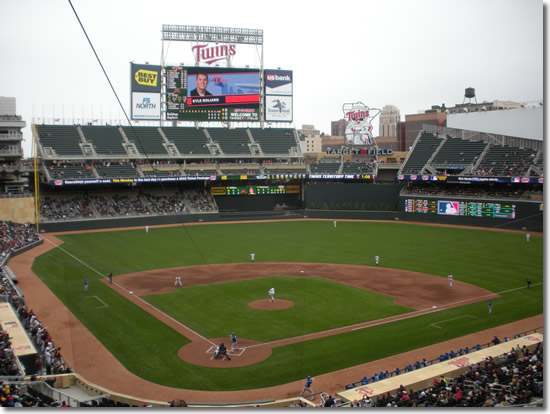 |
|
T. J. Oakes of the Minnesota Gophers delivers the first pitch at Target Field, which opened with a college game on Saturday, March 27. The grass is not the only green feature of the new ballpark as the primary tenant, the Minnesota Twins, have incorporated sustainability, with an emphasis on water, as a significant component. |
The Minnesota Twins’ move to Target Field in Minneapolis means outdoor conditions and real grass after 28 years of an indoor stadium with artificial turf. The change also brings a greater demand for water for irrigation and cleaning.
The Twins have entered into a sustainable partnership, unique in sports, to capture, treat, and use rainwater for their needs. Besides reducing municipal water usage by more than 50 percent, saving more than two million gallons of water each year, the arrangement brings attention to the global issue of water, raising awareness of the value of sustainability and the wise use of water. In addition, a variety of water-related educational opportunities will be used at the new ballpark to elevate the public’s understanding of water stewardship.
“Jim Pohlad, our owner, felt strongly about setting a good example, providing leadership in that area, knowing that sports provides a tremendously high-profile platform,” said Twins president Dave St. Peter.
“We purposely selected water as the resource for sustainability because it’s such an important resource to Minnesotans, whether they drink it or fish in it,” said Kevin Smith, the executive director of public affairs for the team. “The Twins are taking a stand on sustainability and highlighting water.”
St. Peter added, “For us, it became very much of a natural priority based on Minnesota and the strong role water plays with lakes, rivers, as it relates to the brand of Minnesota—a natural play here relative to doing something that nobody else has done.”
 |
 |
Working with Pentair, Inc. of Minneapolis, the Twins developed a system to irrigate their field and wash the stands by recycling rainwater that falls on the field and lower grandstand, an area covering seven acres.
The rainwater and irrigation water within the collection area percolates through Target Field’s underground drainage system and travels through a 12-foot-diameter culvert, which runs under the warning track in the outfield, to a wet well beyond the outfield fence in left-center field.
Pretreatment consists of filtration, disinfection with ultraviolet (UV) light, and chlorination.
The water is then filtered to a level of 0.01 micron using a hollow-fiber ultrafiltration (UF) system at a rate of approximately 125 gallons per minute. The feed and back-pulse pumps for this system are integrated into the skid. The UF system is back-pulsed and cleaned at a frequency based on the build up of pressure due to the accumulation of suspended solids removed by the UF system. The backwash from this filter is discharged to the sanitary sewer.
The water then goes to a holding tank and is re-circulated through another UV disinfection system to maintain water quality. The use of UV with chlorine helps minimize the chlorine needed to maintain the disinfection residual. When there is no demand for water, the treated water accumulates in the holding tank and overflows back to the cistern. When demand exists for water to irrigate the field or wash the grandstand, water booster pumps draw water from the holding tank and supply water at the specified pressure and flow rate.
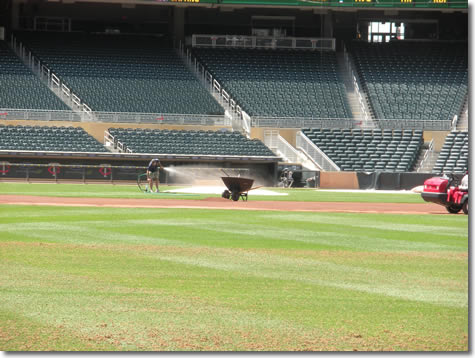 |
|
Above: Rain water at Target Field is captured and used for irrigation and cleaning. Below: Molly Gallatin of the Twins Communications Department by the 12-foot-diameter culverts. |
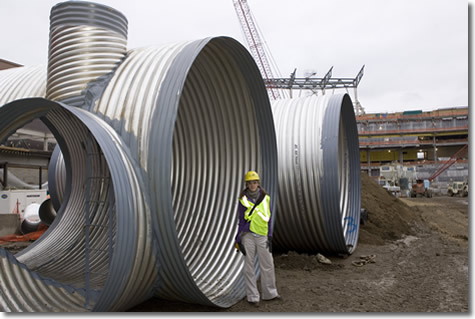 |
The rainwater recycle system was designed to meet the ballparks irrigation needs with two field zones watered simultaneously for two hours at 250 gallons per minute (gpm) and a single field zone watered for four hours at 125 gpm. The washing of the lower grandstand is performed over eight hours with six nozzles at 5 gpm each, totaling 30 gpm. The performance of the system, along with monitoring of the water quality, will be remotely overseen via a website controlled by Instrument Control Systems of Plymouth, Minnesota, in a partnership with Pentair, Inc.
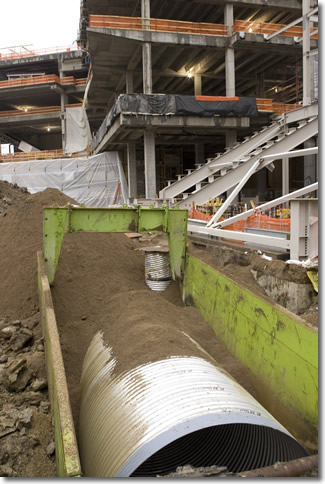 |
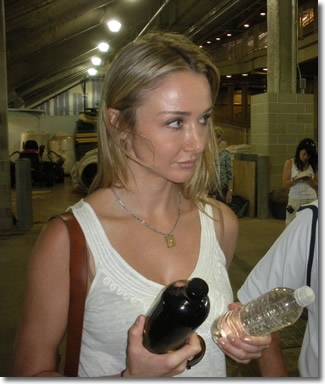 |
|
Above left: Installation of the culverts under the warning track at Target Field in November 2008. Above right: Alexandra Cousteau and her international Blue Planet team toured Target Field and its water treatment system on July 3, 2010, as part of a 100-day, 1,450-mile expedition. The bottle in Cousteau’s right hand contains water from the wet well; the bottle in her left hand contains water that has passed through the filtration system. Below: A panoramic view of the Minnesota Twins versus the Detroit Tigers on May 4, 2010, at Target Field. |
|
 |
|
Target Field uses Minneapolis city water for drinking, and filtration systems have been installed in all suites, clubhouses, training rooms, and offices, setting a “new standard in sports facilities,” according to Twins officials, and further enhancing water quality and reducing the use of bottled water.
On April 8, 2010, Target Field became only the second major professional stadium to become LEED Silver Certified by the U. S. Green Building Council. (LEED, Leadership in Energy and Environmental Design, is a rating system to promote design and construction practices that reduce the impact on the environment and are more profitable than their conventional counterparts.)
Nationals Park in Washington, D. C., which opened in 2008, was the first stadium to receive LEED Certification. Target Field collected the most certification points ever, surpassing Nationals Park by two points. Said St. Peter, “We are very pleased to have the greenest ballpark ever built in America.”
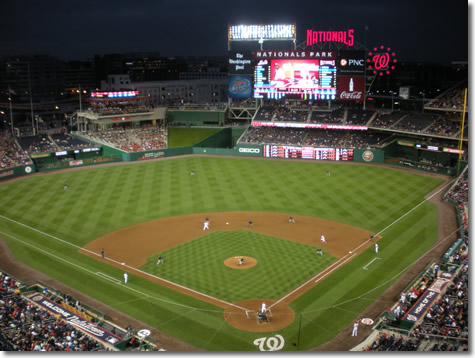 |
|
Above: Nationals Park in Washington, which was the greenest ballpark in the country until it was surpassed by Target Field. Below: The ultrafiltration system has three skids, each containing two sets of four vessels. |
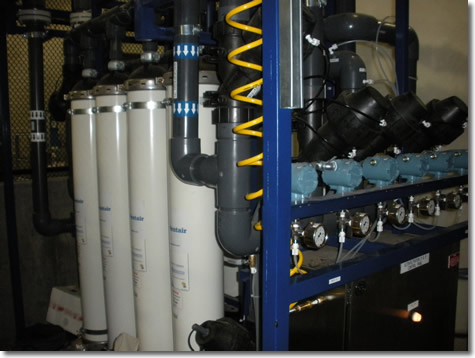 |